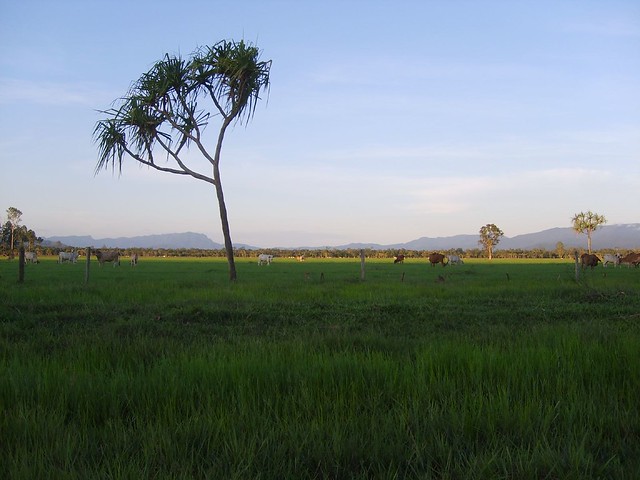
Pasture in Australia ~ photo: flickr
There is a 2008 report out of Australia worth featuring on this blog due to its big picture view of optimal farming methods in a program named "Grain and Graze" which plans for resiliency as both peak oil and climate change advance. Nature's way includes animals in good land management, and advocates of vegetarianism often miss this point. The more natural farming methods do incorporate animals to help enrich the soils and provide protein for food, too.
I have chosen this excerpt from the study:
In any farming system it pays to take a longterm view. Performance can vary significantly from year to year. Systems that can survive poor years (in terms of production, market prices or increased input costs) as well as returning sound profits in better years may be good options even if they don’t deliver the spectacular returns offered by other systems in a big year. There is value in the adage that slow and steady wins the race.
PRODUCTION
Mixed farming enterprises are, by nature, more resilient than monocultures, offering farmers a greater array of choices in dealing with market and climate variation. There are also important synergies between different enterprises. For example, using stock to break down heavy stubbles or graze out weeds saves on pasture and costs less than tillage or spraying. Weeds that are resistant to herbicides are still highly susceptible to sheep and, with the rise in resistance, grazing is becoming an increasingly important part of the strategy for controlling weeds in following crops.
With the world facing ‘peak oil’ * and rising energy prices likely to affect the cost of fuel, fertilisers and chemicals used in cropping, the livestock enterprise offers a means to balance income, limit costs and still lift overall farm productivity.
In many areas, farms include different types of country and soil types, so mixed farming is a way to optimise total production. Using land to its capability (e.g. cropping on flats while grazing hilly country) enables the whole property to be productive while also getting the best financial return for all inputs (e.g. not wasting fertiliser on less responsive land). Having livestock in the system is also a potent way of managing, or bringing back, less productive or degraded lands, like salt-affected areas. Once the capital costs of establishing pastures in these areas are covered, they can again be profitable components of the farming system.
On farms with high physical variation it may make more sense to use the quality land exclusively for high-input farming, and adopt a very different management approach in the rougher country, using few inputs and grazing stock strategically.
On farms where the country and soils are relatively uniform, stock and crops can be closely intertwined, taking full advantage of the way they support one another and using the benefits of rotating between pasture and cropping phases, such as: nitrogen build up from pasture legumes; increased soil organic matter from grass legume pastures; benefits to disease and weed control from rotations; and using cropping as a step in renovating pastures.
Some producers have reduced their grazing activity to focus on cropping, because it can deliver the highest return in a good year. On some soils, there may be issues about soil compaction from stock and, if poorly managed during drought, stock can cause erosion and loss of fertility. However, there are equivalent concerns about soil compaction from heavy machinery and erosion from tilling sloping soils, which can, in turn, be addressed by precision agriculture and controlled traffic cropping, etc. These illustrate the complexity of issues and options that surround even basic questions in mixed farming.
*PEAK OIL: The time when the rate of production of oil will peak before declining as global reserves are drawn down. Predictions are that humanity is now at, or nearing, ‘peak oil’ and that scarcity and irregularity of supply will force prices up as availability declines and demand rises. This is likely to cause increases in the price of many farm inputs, including fuel, fertiliser and pesticides and in the cost of transporting farm produce.
The "Grain and Graze" method decreases input costs, decreases reliance upon fossil fuels, increases productivity, preserves the land, decreases the need for chemicals, helps to reduce greenhouse emissions, and is more resilient in challenging weather years. Adopting a plan such as this might serve as a smart insurance policy in preparing for the future. Now, if we can turn out more large animal vets, I envision a bucolic Midwest return to smaller farms, more young people, cow-calf operations using rotational grazing methods, and dancing in the small town streets on Saturday nights.
K. McDonald
h/t Jason Bradford